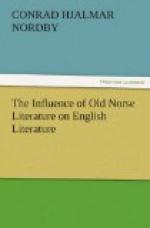Book III opens with the dream of Gudrun and Brynhild’s interpretation of it. This matter is managed in accordance with our own standards of art, and thus differs materially from the saga story. In the latter a most naive procedure is adopted, for Brynhild prophesies that Sigurd shall leave her for Gudrun, through Grimhild’s guile, that strife shall come between them, and that Sigurd shall die and Gudrun wed Atli. The whole later story is thus revealed. This is not a story-teller’s art, but it sets clear the Old Norse acceptance of fate’s dealings. Of course Morris’ poetic action explains the dream perfectly, but the details are not so frankly given.
“Thou shalt live and love and lose, and mingle in murder and war,” is the gist of Brynhild’s message, and the whole future history is there.
This poem has often been called an epic, and certainly there are many epical characteristics in it. One of them is the recurrence of certain formulas, and in Books III and IV these are rather more abundant than in the first two books. Thus the sword of Sigurd is praised in the same words, again and again:
It hath not its like in the heavens nor has earth of its fellow told.
Then, there is the “cloudy hall-roof” of the Niblungs. Gudrun is “the white-armed”; Grimhild is “the wisest of women”; Hogni is the “wise-heart”; the Niblungs are “the Cloudy People”; their beds are “blue-covered”; “the Godson the hangings” is an expression that recurs very often, and it recalls the fact that Morris was an artisan as well as an artist.
In the preceding books we have noted that Morris lengthened the saga story in his poem by the introduction of speeches that find no place in the original. In this book we see another lengthening process, which, with that already noted, goes far to account for the difference in bulk between the saga and the poem. Chap. XXVI of the saga, tells in less than a thousands words how Sigurd comes to the Giukings and is wedded to Gudrun. His reception is told in one hundred words; his abode with the Giukings is set forth in even fewer words; Grimhild’s plotting and administering of the drugged drink are told in two hundred words; his acceptance of Gudrun’s hand and her brother’s allegiance are as tersely pictured; kingdoms are conquered, a son is born to Sigurd, and Grimhild plots to have Sigurd get Brynhild for her son Gunnar, yet the record of it all is compressed within one hundred and fifty words. Of course, the modern poet can hem himself within no such narrow bounds as this. The artistic value of these various incidents is priceless, and Morris has lingered upon them lovingly and long. He spreads the story over forty pages, or a thousand lines, and I avow, after a third reading of these three sections of the poem, that I would spare no line of them. How we love this Sigurd of the poet’s painting! And what a noble gospel he proclaims to the Giukings:




